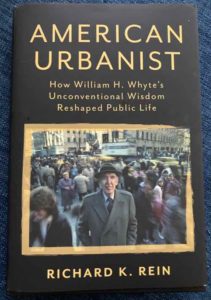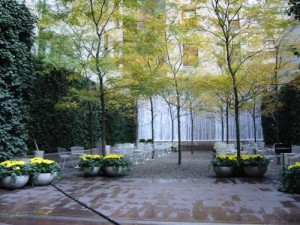New Book — ‘American Urbanist: How William H. White’s Unconventional Wisdom Shaped Public Life’ by Richard K. Rein
 Willam H. Whyte is one of two people who influenced how I see our built environment, the other is Jane Jacobs. Had I known about either in 1985 I probably would’ve studied urban planning instead of architecture. Both focus on observation, but in very different ways.
Willam H. Whyte is one of two people who influenced how I see our built environment, the other is Jane Jacobs. Had I known about either in 1985 I probably would’ve studied urban planning instead of architecture. Both focus on observation, but in very different ways.
On an otherwise normal weekday in the 1980s, commuters on busy Route 1 in central New Jersey noticed an alarming sight: a man in a suit and tie dashing across four lanes of traffic, then scurrying through a narrow underpass as cars whizzed by within inches. The man was William “Holly” Whyte, a pioneer of people-centered urban design. Decades before this perilous trek to a meeting in the suburbs, he had urged planners to look beyond their desks and drawings: “You have to get out and walk.”
American Urbanist shares the life and wisdom of a man whose advocacy reshaped many of the places we know and love today—from New York’s bustling Bryant Park to preserved forests and farmlands around the country. Holly’s experiences as a WWII intelligence officer and leader of the genre-defining reporters at Fortune Magazine in the 1950s shaped his razor-sharp assessments of how the world actually worked—not how it was assumed to work. His 1956 bestseller, The Organization Man, catapulted the dangers of “groupthink” and conformity into the national consciousness.
Over his five decades of research and writing, Holly’s wide-ranging work changed how people thought about careers and companies, cities and suburbs, urban planning, open space preservation, and more. He was part of the rising environmental movement, helped spur change at the planning office of New York City, and narrated two films about urban life, in addition to writing six books. No matter the topic, Holly advocated for the decisionmakers to be people, not just experts.
“We need the kind of curiosity that blows the lid off everything,” Holly once said. His life offers encouragement to be thoughtful and bold in asking questions and in making space for differing viewpoints. This revealing biography offers a rare glimpse into the mind of an iconoclast whose healthy skepticism of the status quo can help guide our efforts to create the kinds of places we want to live in today. (Island Press)
He was right, in-person observation is incredibly valuable. Photos, videos, etc are good, but the best observations are made in person. This is why for 17+ years I like to visit places in person before posting about them here.
You can read some preview pages of this hardcover book here.
— Steve Patterson

